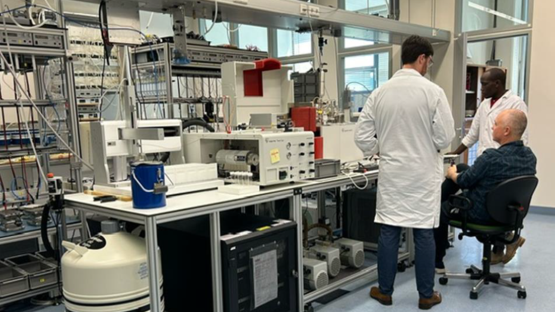A new IAEA coordinated research project (CRP) will investigate the impact of nutrient pollution from land-based sources on coastal eutrophication and the formation of harmful algal blooms.
Linking Nutrient Fluxes, Eutrophication and Harmful Algal Blooms
In the IAEA Isotope Hydrology laboratory, staff analyse the nitrogen and oxygen isotopic composition of dissolved nitrate by Isotope Ratio Mass Spectrometry (shown here).? These data provide information about the source of nitrate contamination in water samples.?(Photo: J. McKay/IAEA)
Nutrients and Eutrophication
Every year, human activities add large amounts of nutrients, primarily nitrogen and phosphorous, to freshwaters. These nutrients cause excessive plant growth, which is referred to as a large algal bloom. This process is referred to as eutrophication. Eutrophication is a problem of global concern as it is linked to the frequency and severity of harmful algal blooms (HABs) that produce toxins, which harm not only the organisms living in the water but also humans who eat those organisms or drink the water.
HABs are common in freshwater environments. Such algal blooms have significant impacts on water quality and potability, as well as on economies in affected regions. A significant amount of work has gone into managing the accumulation of excess nutrients in freshwater bodies. However, these nutrients can be derived form a wide variety of sources including agricultural runoff, sewage discharge, atmospheric deposition and industrial pollution, making the study of these nutrients complicated. Furthermore, land use changes combined with climate change (e.g., extreme rainfall events) are washing a greater amount of nutrients into freshwater systems.
Linking the Terrestrial and Marine Environments
Ultimately, these nutrients are transported by freshwater (such as rivers, groundwater and surface runoff) to the coastal ocean where eutrophication and HABs also occur. As nutrient flux to the terrestrial to coastal environment continues to increase and seawater temperatures rise, coastal eutrophication leading to toxic HABs is becoming more prevalent. This is a problem of global concern because the safety of seafood, particularly shellfish and other organisms that bioaccumulate the toxins, is jeopardized, with significant economic implications.
Rethinking an Old Problem
Eutrophication in the coastal environment is not a new problem and its link to the influx of terrestrially derived nutrients is well known.?Despite this, the problem continues to grow around the world, and mitigation techniques, such as reducing fertilizer use, do not always help.?Clearly, some parts of the puzzle are missing.?Addressing this knowledge gap is crucial for managing eutrophication and, consequently, mitigating impacts related to HABs.
“Properly understanding how freshwater systems transport nutrients to the coastal zone and in what form is key to developing better strategies for efficient and long-lasting terrestrial nutrient reduction policies that contribute to ocean protection,” said Jodie Miller, head of the IAEA Isotope Hydrology Section.
“Identifying the sources of nutrients on land that drive eutrophication in excess and HABs in coastal areas are key to developing efficient and long-lasting, nutrient reduction policies to protect the ocean,” said Jana Friedrich, head of the IAEA Radioecology Laboratory. “With such actionable knowledge, which we hope to acquire through this CRP, our Member States will be better equipped to underpin solid policy proposals.”
Isotopic techniques, for example the analysis of oxygen and nitrogen stable isotopes in nitrate, can distinguish between various terrestrial nutrient sources (including fertilizer, sewage and industrial pollution). This enables the origin of the nutrients to be determined as well as providing information about pathways and transformation as the nutrients move from the terrestrial to the coastal environment. Under the framework of this project (CRP F33030), researchers will apply these methods to determine not only where the nutrients are coming from but also how they are transported from the terrestrial to the coastal environment and how these inputs vary seasonally and in response to land-use changes. By providing this evidence-based insight, isotope hydrology supports more targeted, effective management strategies for protecting coastal ecosystems and human health from the cascading impacts of HABs.
Through this CRP, the IAEA will support the development, refinement and harmonization of techniques to assist countries in assessing terrestrial nutrient fluxes to the coastal environment and improve understanding of how these nutrient fluxes impact eutrophication. This CRP is intended to be complementary to another CRP (K41027), which supports research on harmful algal blooms specifically in the marine environment.
CRP Overall Objectives
The overall objective is to enhance the global understanding of the impact of nutrient pollution from land-based sources on coastal eutrophication. This CRP will directly contribute to sustainable development goal (SDG) 6.3, which aims to improve water quality and reduce freshwater pollution and SDG 14.1, which aims to prevent and significantly reduce marine pollution of all kinds, with a particular focus on land-based activities, including nutrient inputs and their detrimental effects. ntact form on the CRP page.
Specific Research Objectives
- To develop new and improved isotopic techniques to characterize terrestrial nutrient sources and quantify nutrient fluxes to the coastal zone.
- To examine how abiotic (i.e., physical) factors impact eutrophication.
- To determine how different types of nutrients and the proportion of one nutrient to another influence eutrophication.
- To identify and evaluate the processes, driven by anthropogenic change, that contribute to increased terrestrial nutrient fluxes to the coastal environment.
- To harmonize guidelines for quantifying nutrient fluxes across the land-ocean interface and to communicate and disseminate the results.
Research institutions interested in joining the CRP must submit their Proposal for Research Contract or Agreement via email, no later than July 31, 2025, to the IAEA’s Research Contracts Administration Section, using the appropriate template on the CRA web site. The IAEA is committed to gender equality and to promoting a diverse workforce. Applications from qualified women and candidates from developing countries are strongly encouraged.
For further information related to this CRP, potential applicants should use the contact form on the CRP page.



